Pesto alla Genovese (Classic Basil Pesto) is a bright and herby sauce that adds flavor to many dishes! All you need to do to make this traditional Italian recipe is blend the ingredients then enjoy it with pasta, chicken, sliders, and more.

This quintessential Italian sauce is peppery, garlicky, and super versatile! We love to make a big batch then use it throughout the week for our favorite dinners like our Sausage Pesto Pasta with Rapini or Veggie Pesto Pasta, Skillet Sliders, or Mozzarella-Stuffed Chicken Pomodoro.
Jump to:
About Pesto Alla Genovese
- Taste - The combination of fresh basil, olive oil, cheese, and toasted pine nuts creates an herby and richly flavored sauce.
- Texture - The pesto is thick and creamy yet light.
- Effort - All you need to do is mix the ingredients in the food processor.
- Time - It takes just 5 minutes to whip up this classic pesto.
Ingredients

- Fresh basil - Basil provides the signature herby freshness to the pesto sauce. Genovese basil offers a peppery flavor and earthy aroma; whereas, sweet basil is sweeter and fragrant.
- Parmigiano-Reggiano - Grated Parmigiano-Reggiano adds a nutty sharpness.
- Pecorino Romano - Pecorino adds a savory and tangy accent.
- Pine nuts - Pine nuts add a rich nuttiness to the sauce. Toast them for an extra rich and nutty flavor.
- Garlic cloves - Garlic cloves add the quintessential aroma.
- Kosher salt - Kosher salt accentuates the rich flavors of the pesto.
- Extra virgin olive oil - Olive oil is an emulsifier that brings the sauce together.
See recipe card for quantities.
Substitutions
- Kale pesto - Try our Kale Walnut Pesto recipe with fresh torn kale for an earthy alternative.
- Nut-free pesto - If you are allergic to nuts or just want to keep fat calories down, you can omit the nuts, or use sunflower seeds instead.
- Parmesan Cheese - You can use grated parmesan cheese if you don't have Parmigiano-Reggiano.
- Walnuts - Use walnuts instead of pine nuts if you prefer a cheaper option.
- Pistachios - Check out our pistachio pesto for a uniquely nutty and rich pesto.
Variations
- Spicy - Add freshly ground black pepper or red pepper flakes for a little spice.
- Lemon Juice - Add a tablespoon of fresh lemon juice or a little lemon zest for extra acidity and brightness.
- Spinach pesto - Add spinach to make this a spinach pesto if you like the taste.
- Vegan - Omit the cheese to make this recipe vegan and dairy free.
- Super food pesto - Use a mix of spinach, arugula, basil, and baby kale for a delicious super food pesto.
Instructions

- Chill basil leaves - Place the basil leaves in a mixing bowl with cold water and ice. Allow to chill for 5 minutes, then drain and dry with a paper towel or clean kitchen towel.
- Add ingredients to food processor - Add pine nuts, Parmigiano-Reggiano, pecorino romano, garlic, salt, and basil leaves to a food processor. Pulse until it becomes a sandy consistency.
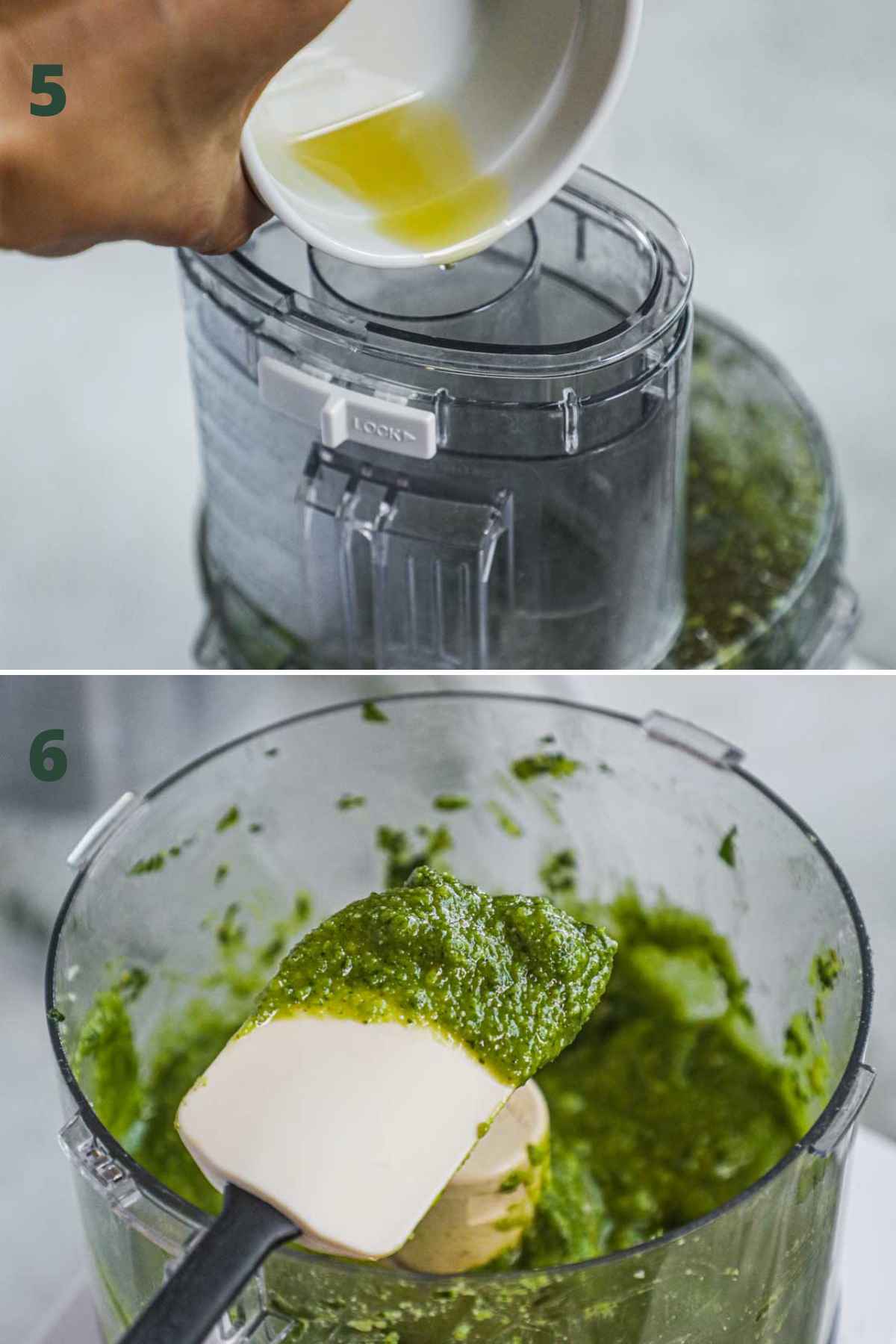
- Add olive oil - Then stream in the olive oil, pulsing a couple of times to mix. Remove the container top and blade then give the pesto a good stir. This will keep the olive oil from heating and changing flavor.
Pro tip - Place the food processor container and blade in the freezer to chill before making the pesto. This will ensure the ingredients will not heat up in the food processor.
What to Serve With Basil Pesto
This basil pesto is super versatile and can be enjoyed as a sauce for pasta or chicken or as a spread for burgers and sliders. Whenever we make this pesto, we make enough for the whole week for multiple meals.
Storage
Store this gluten free basil pesto in an air-tight container in the refrigerator up to 5 days. Be sure to add a thin layer of olive oil to seal out the air and prevent the sauce from oxidizing and turning brown. You can also freeze the pesto in a freezer safe container for up to 6 months. When you are ready to enjoy it, let it thaw in the fridge or at room temperature.
Top Tips
- Please do not use iodized table salt. This will give the pesto a metallic taste. Use kosher salt or sea salt instead.
- Use a baking spatula to scrape all of the pesto from the food processor and eliminate food waste.
- If you store and refrigerate the pesto, be sure to mix it again before using it. The ingredients can separate while stored in the refrigerator.
- For extra rich and nutty flavor, toast the pine nuts before you put them in the food processor.
Recipe FAQs
Pesto Genovese originated in the city of Genoa, in Liguria (Northern Italy). This classic Italian pesto has been around for centuries, but the first modern recipe was in Giovanni Battista Ratto's 1863 book La Cuciniera Genovese.
Yes! While it can be tempting to go with store-bought pesto, homemade basil pesto is both tastier and healthier. It is so easy and only takes 5 minutes to make!
Pesto can become bitter if it is mixed in the food processor too long. The olive oil contains bitter tasting polyphenols, which can get squeezed out if they are over processed.
Pesto can turn brown if it oxidizes while stored in the fridge. In order to avoid this, try adding a thin layer of olive oil above the pesto to seal out the air.
Yes! Pesto ingredients may reduce your risk of heart disease, diabetes, and cancer. Also note that homemade pesto is typically healthier than store-bought.
Yes, it will just be a little trickier. You will need to use a spatula in between blending to move the ingredients around.
In order to make it thinner, add more olive oil. If you want to make it thicker, add more cheese and basil.

Related Recipes
Did You Like This Recipe?
Love this classic basil pesto recipe? Please leave a 5-star rating in the recipe card below & consider leaving a comment below. Thanks!
Sign up for THP's newsletter and keep in touch on Instagram, Facebook, Pinterest, TikTok, and YouTube. If you make this recipe, tag #theheirloompantry so we can see your pesto genovese!
📖 Recipe
Pesto alla Genovese (Classic Basil Pesto)
Equipment
- 1 knife
Ingredients
- 2 cups Genovese basil leaves or fresh sweet basil
- 2 tablespoon pine nuts toasted
- ½ cup Parmigiano-Reggiano cheese
- ¼ cup pecorino romano
- 2 garlic cloves
- ½ cup extra-virgin olive oil
- ½ teaspoon kosher salt or sea salt
Instructions
- Chill basil - Place the basil leaves in a mixing bowl with cold water and ice. Allow to chill for 5 minutes, then drain and dry with a paper towel or clean kitchen towel.2 cups Genovese basil leaves or fresh sweet basil
- Blend ingredients - Add pine nuts, Parmigiano-Reggiano, pecorino romano, garlic, salt, and basil leaves to a food processor. Pulse until it becomes a sandy consistency, then stream in the olive oil, pulsing a couple of times to mix. Remove the container top and blade then give the pesto a good stir. This will keep the olive oil from heating and changing flavor.2 cups Genovese basil leaves or fresh sweet basil, 2 tablespoon pine nuts, ½ cup Parmigiano-Reggiano cheese, ¼ cup pecorino romano, 2 garlic cloves, ½ teaspoon kosher salt or sea salt, ½ cup extra-virgin olive oil
Video
Notes
- Refrigerate leftover pesto in an air-tight container for up to 5 days. Be sure to add a thin layer of olive oil to seal out the air and prevent the sauce from oxidizing and turning brown. You can also freeze the pesto for up to 6 months. When you are ready to enjoy it, let it thaw in the refrigerator or at room temperature.
- Chill the food processor container and blade in the freezer before making the pesto. This will ensure the ingredients will not heat up in the food processor.
- Use kosher salt or sea salt instead. Do not use iodized table salt. This will give the pesto a metallic taste.
- Use a baking spatula to scrape all of the pesto from the food processor.
- If you store and refrigerate the pesto, be sure to mix it again before using it. The ingredients can separate while refrigerated.
- For extra rich and nutty flavor, toast the pine nuts.



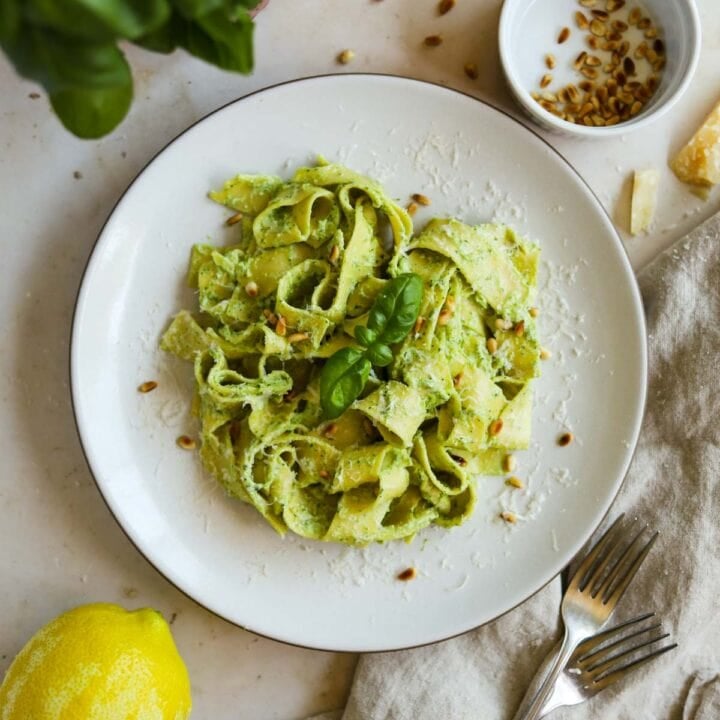


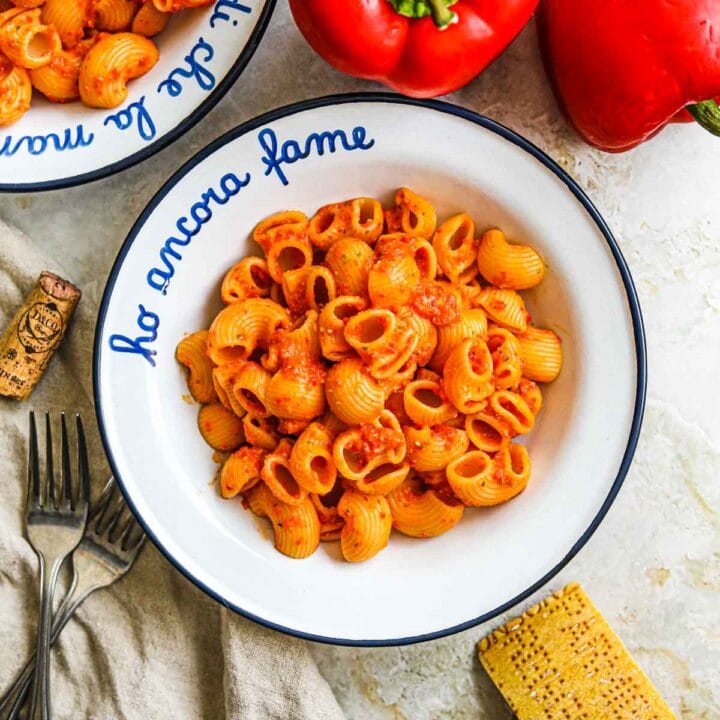



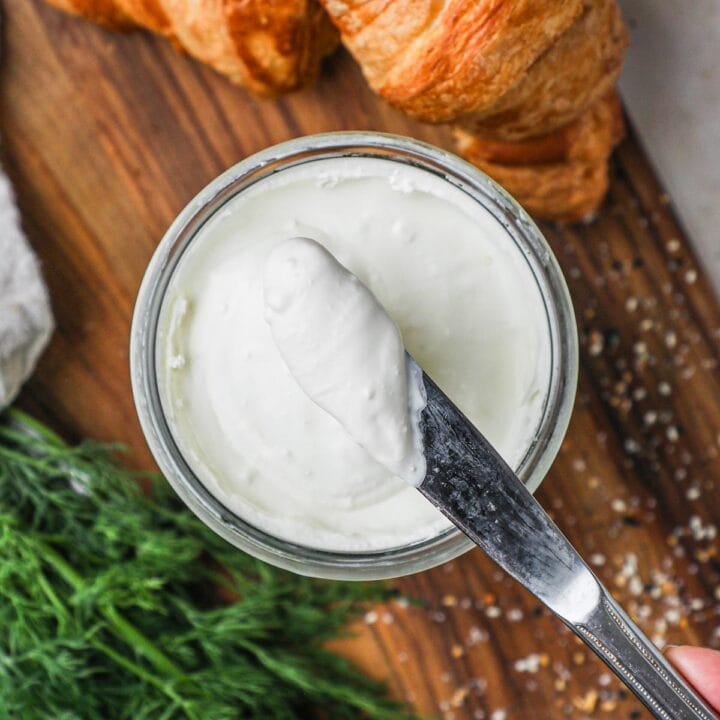
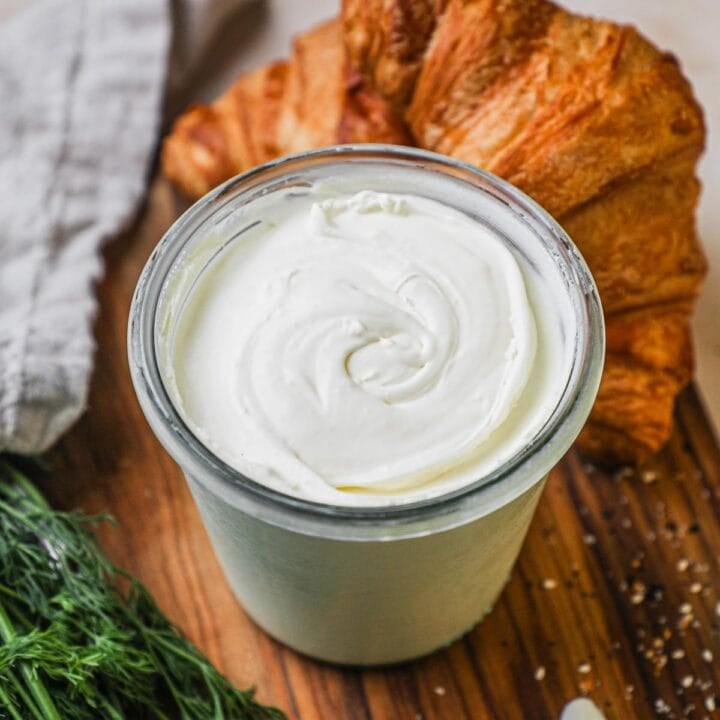
Leave a Reply